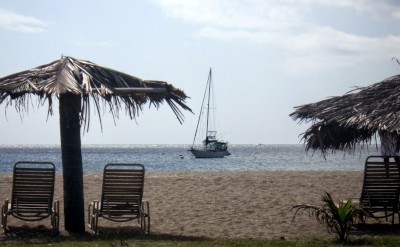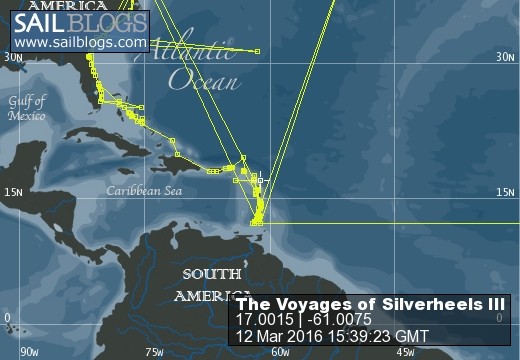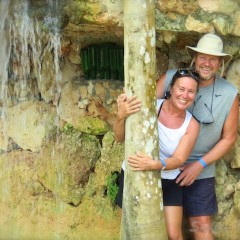
The Voyages of s/v Silverheels III
...a virtual ship's logbook, and some thoughtful (unabashed?) reflections on our sea-going experiences.
04 November 2017 | Somewhere in the Eastern Caribbean
18 October 2017 | Le Marin, Martinique in the French West Indies
25 January 2017 | Gosier, Guadeloupe
19 January 2017 | Le Gosier, Guadeloupe
19 January 2017 | Le Gosier, Guadeloupe
19 January 2017 | St Pierre, Martinique
06 January 2017
01 January 2017 | Fort Du France, Martinique
28 December 2016 | Grand Anse d'Arlet, Martinique
24 December 2016
14 November 2016 | St Anne, Martinique
06 October 2016 | St Anne, Martinique
04 October 2016
20 July 2016 | Rodney Bay, St Lucia
15 June 2016
15 June 2016
13 June 2016
13 June 2016 | Grand Anse d'Arlets
13 June 2016 | Grand Anse d'Arlets
09 May 2016 | Deshaies, Guadeloupe
Prepping an Older Boat for Cruising
13 November 2014 | Woburn, Grenada
Lynn

We have had emails, comments and Facebook discussions with people about preparing an older boat for cruising. I figured it might be easier to make this into a Blog, and then I can just recycle it in emails! Actually, we have found that some people actually do pay some attention to our opinions... and some would say that is misguided.
So, here is the list of the top ten things we recommend when prepping an older boat for cruising:
1) Seriously consider repowering. An old diesel, or generator, can create a world of pain farther along when cruising. Get a well known, common brand diesel and put it in. The newer diesels are lighter for more horsepower, and much more fuel efficient. Besides, hearing people plead on a cruisers' net for parts for a 30 year old diesel is sad. Yes, it may be a sailboat, but diesels still get used.
2) Reinsulate your refrigerator. This is for ANY boat. Fridges can be big power suckers when they have to run far too often due to lousy insulation. That 2" of cheap foam that may or may not be water sodden isn't doing the job. Get the extruded polystyrene (commercially known as Styrafoam SM) and get about 6" in there. This stuff is vapour proof, rigid and cheap. It also won't absorb water, which is important since humidity in the fridge is not your friend. Since most old boats originally had ice boxes, you should still have sufficient room for your food. While you are at it, consider upgrading your refrigeration unit. Poor refrigeration with half dead batteries is one of the causes for running the wheels off the diesel to charge the system.
3) Don't worry too much about rewiring AC. You will probably spend most of your time at anchor, so will be DC dependent anyway. It will be the same on the dock. Get a good multivolt and dual frequency battery charger and you can go on any power dock, a real bonus when cruising. You'll need some dockside 110VAC 60hz capability for your run up or down the AICW in the fall or spring to run electric heaters. It's also nice to have 110VAC on the hard if it's available in the boatyards. Remember, in Eastern Caribbean most shorepower is European standard 230VAC @50 hz. We haven't needed shoreside AC power inside the boat since we left Toronto 6 years ago, so save the money on the rewiring for something else like...
4) Solar panels. No moving parts, and the technology just keeps getting better and better. This is something I would say is better to make as a last minute installation as the improvements from year to year are impressive. Wind generators have moving parts, aren't cheap, can be noisy, and have far less bang for the buck. If you can't run your boat overnight without a charging source, you don't have enough battery capacity.
5) Inverter. Get a couple of inverters to cover your AC needs, like charging computers or running tools. We have one heavy duty 2500w with a 3500w peak beast that will work any power tool we have, albeit it not indefinitely as we don't have infinite battery capacity! We also have a smaller one that happily charges computers and other stuff. We prefer not to have all of our eggs in one basket. Charger/Inverter combined units are not a good plan, in our opinion. We have heard many cruisers asking for help when the inverter dies... Separate units means the death of one doesn't mess up your use of the other.
6) Think about changing your rigging. We had old rod rigging that was original to our boat. We ditched it. Rigging does not last forever, and it is easier to get it taken care of on the Continent than somewhere that you may not have much choice. This goes for running rigging, too.
7) This goes for anyone, regardless of age of boat. Get an MMSI, plug it into your radio, and learn how to use the DSC capabilities. Make sure your chartplotter is hooked up to the radio. Yes, chartplotter... we don't believe in having all of your navigation on a computer, as they tend to crash, and you can't always have it where you need it when you need it, like in the cockpit when it is heaving down rain as you are entering a harbour. We use the computer for planning, but use a chartplotter (2, in fact) at the pedestal.
8) Put access ports, if possible, on your tanks. We can clean out our fuel tank or our water tanks quite easily, and we do them regularly. We aren't waiting for sludge to gum up our fuel filters (and it certainly happens!), and the water tanks can collect a bit of "stuff" sometimes.
9) Get simple batteries, and as many as you can afford and stuff in your boat. Really, a basic boat like ours has a capacity of 690 amp hours (so approximately 230 hours useable amp hours). This gives us about 72 hours of power even with no charging. Or 1 hour with the heat gun on! We prefer lead acid batteries as they can be maintained, and are suspicious of "bleeding edge" technology.
10) Have some redundancy in your systems. We don't have pressure water on our boat, and that is our choice, but having some foot pumps as a back up is not a bad idea. We have seen boats have problems with their pressure water, or electrical system, and couldn't even get a glass of water. Having manual backups to some of the mechanized systems can make things liveable while waiting to repair the problem.
This is our basic list of things that we think anybody outfitting and working on an older boat for cruising should consider. Some of this can be applicable to someone buying an older boat for weekending and holidays, but certainly if you plan to join us one day in the tropics.
So, here is the list of the top ten things we recommend when prepping an older boat for cruising:
1) Seriously consider repowering. An old diesel, or generator, can create a world of pain farther along when cruising. Get a well known, common brand diesel and put it in. The newer diesels are lighter for more horsepower, and much more fuel efficient. Besides, hearing people plead on a cruisers' net for parts for a 30 year old diesel is sad. Yes, it may be a sailboat, but diesels still get used.
2) Reinsulate your refrigerator. This is for ANY boat. Fridges can be big power suckers when they have to run far too often due to lousy insulation. That 2" of cheap foam that may or may not be water sodden isn't doing the job. Get the extruded polystyrene (commercially known as Styrafoam SM) and get about 6" in there. This stuff is vapour proof, rigid and cheap. It also won't absorb water, which is important since humidity in the fridge is not your friend. Since most old boats originally had ice boxes, you should still have sufficient room for your food. While you are at it, consider upgrading your refrigeration unit. Poor refrigeration with half dead batteries is one of the causes for running the wheels off the diesel to charge the system.
3) Don't worry too much about rewiring AC. You will probably spend most of your time at anchor, so will be DC dependent anyway. It will be the same on the dock. Get a good multivolt and dual frequency battery charger and you can go on any power dock, a real bonus when cruising. You'll need some dockside 110VAC 60hz capability for your run up or down the AICW in the fall or spring to run electric heaters. It's also nice to have 110VAC on the hard if it's available in the boatyards. Remember, in Eastern Caribbean most shorepower is European standard 230VAC @50 hz. We haven't needed shoreside AC power inside the boat since we left Toronto 6 years ago, so save the money on the rewiring for something else like...
4) Solar panels. No moving parts, and the technology just keeps getting better and better. This is something I would say is better to make as a last minute installation as the improvements from year to year are impressive. Wind generators have moving parts, aren't cheap, can be noisy, and have far less bang for the buck. If you can't run your boat overnight without a charging source, you don't have enough battery capacity.
5) Inverter. Get a couple of inverters to cover your AC needs, like charging computers or running tools. We have one heavy duty 2500w with a 3500w peak beast that will work any power tool we have, albeit it not indefinitely as we don't have infinite battery capacity! We also have a smaller one that happily charges computers and other stuff. We prefer not to have all of our eggs in one basket. Charger/Inverter combined units are not a good plan, in our opinion. We have heard many cruisers asking for help when the inverter dies... Separate units means the death of one doesn't mess up your use of the other.
6) Think about changing your rigging. We had old rod rigging that was original to our boat. We ditched it. Rigging does not last forever, and it is easier to get it taken care of on the Continent than somewhere that you may not have much choice. This goes for running rigging, too.
7) This goes for anyone, regardless of age of boat. Get an MMSI, plug it into your radio, and learn how to use the DSC capabilities. Make sure your chartplotter is hooked up to the radio. Yes, chartplotter... we don't believe in having all of your navigation on a computer, as they tend to crash, and you can't always have it where you need it when you need it, like in the cockpit when it is heaving down rain as you are entering a harbour. We use the computer for planning, but use a chartplotter (2, in fact) at the pedestal.
8) Put access ports, if possible, on your tanks. We can clean out our fuel tank or our water tanks quite easily, and we do them regularly. We aren't waiting for sludge to gum up our fuel filters (and it certainly happens!), and the water tanks can collect a bit of "stuff" sometimes.
9) Get simple batteries, and as many as you can afford and stuff in your boat. Really, a basic boat like ours has a capacity of 690 amp hours (so approximately 230 hours useable amp hours). This gives us about 72 hours of power even with no charging. Or 1 hour with the heat gun on! We prefer lead acid batteries as they can be maintained, and are suspicious of "bleeding edge" technology.
10) Have some redundancy in your systems. We don't have pressure water on our boat, and that is our choice, but having some foot pumps as a back up is not a bad idea. We have seen boats have problems with their pressure water, or electrical system, and couldn't even get a glass of water. Having manual backups to some of the mechanized systems can make things liveable while waiting to repair the problem.
This is our basic list of things that we think anybody outfitting and working on an older boat for cruising should consider. Some of this can be applicable to someone buying an older boat for weekending and holidays, but certainly if you plan to join us one day in the tropics.
Comments
| Vessel Name: | Silverheels III |
| Vessel Make/Model: | Hinterhoeller, Niagara 35 Mk1 (1979) |
| Hailing Port: | Toronto |
| Crew: | Lynn Kaak and Ken Goodings |
| About: | After five summers and winters living on our boat in Toronto Harbour, we've exchanged those cold Canadian winters for Caribbean sunshine. "Nowadays, we have ice in our drinks, not under the boat." |
| Extra: |
The completely biased and unabashed musings from the crew of Silverheels III

Who: Lynn Kaak and Ken Goodings
Port: Toronto




















